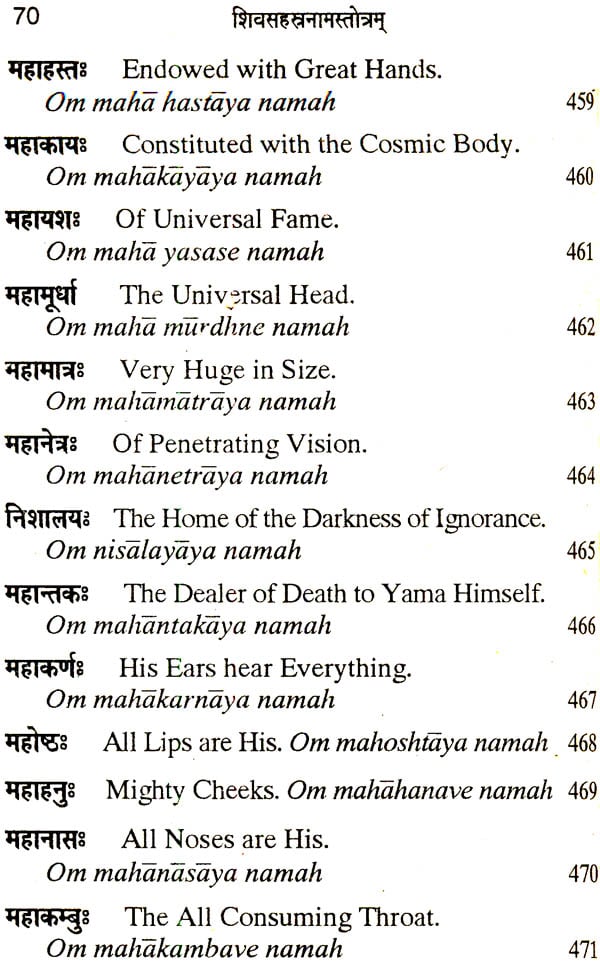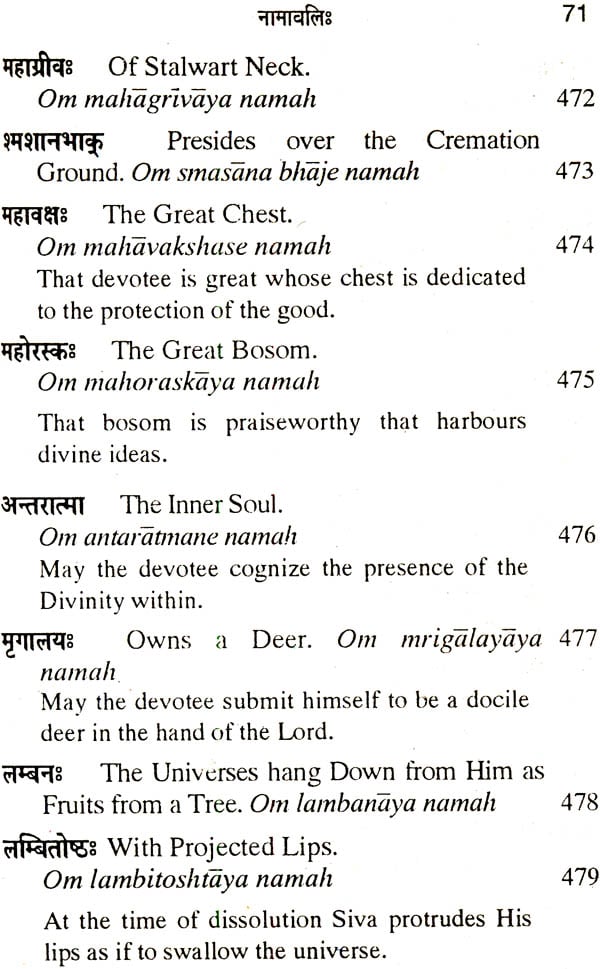
Siva Sahasranama Stotram (With Roman and Meaning of Each Name)
Book Specification
| Item Code: | NAE479 |
| Author: | Swami Chidbhavananda |
| Publisher: | SRI RAMAKRISHNA TAPOVANAM |
| Language: | English |
| Edition: | 2018 |
| ISBN: | 8180851605 |
| Pages: | 128 |
| Cover: | Paperback |
| Other Details | 7.0 inch X 5.0 inch |
| Weight | 90 gm |
Book Description
The Vedic Religion popularly known as Hinduism stands on a pedestal of its own. This pedestal is equated with the Noumenon. The eternal verity is its basis. Further this religion has characteristics peculiar to itself. They are based on Universalism. The other religions of the world are all named after their founders. Whereas this ancient religion has no name of its own. For the sake of distinction it is called the Sanatana Dharma. It means the Eternal Law. This Law again is not man made. The Law and the Source of the Law are identical. In other words the Law and the Law-maker are one and the same. The grandeur of the working of Nature comes to he known through this Law. It permeates the whole of creation. This way the Vedic Religion is both eternal and universal. The other religions of the world have their origin in time. History bears evidence to the periods of their inception. In contrast with them Sanatana Dharma stands untouched by time. History and tradition dare not peep into the source of this religion. The other religions formulated by man have their limitations. They have their indoctrinated creeds. The creeds again come into conflict with one another. In contrast with them the Sanatana Dharma invites investigation into its verity. It ever stands on truth. The Gods of the formulated religions have their partialities, prejudices, likes and dislikes. But the Cosmic Reality of Hinduism is the infallible Principle. It is not a Person. It is the all powerful and all pervasive Intelligence that governs the universe. These are some of the differences between the formulated religions and the Sanatana Dharma.
A fully evolved religion to be vibrant, universal, purposeful and productive, must have four indispensable limbs - the philosophy, the epics, the mythology and the rituals. The structure of Sanatana Dharma is perfect in this respect. It serves in detail all the requirements of human life at all levels. The mundane, the ethical, the emotional and the spiritual needs of man are all abundantly and meticulously provided for.
Among the four limbs absolutely essential to an active religion, the Philosophy stands first and foremost. Generalized science is philosophy. It expounds the truths pertaining to life. They are all axioms. The more man translates them into life the more man evolves. Darsana is the apt Sanskrit word for philosophy. It means the insight into the fundamentals pertaining to life. The Indian system of philosophy is divided into six schools one evolving into the other. All of them, arranged in order, epitomize the human progress into perfection.
The Vaiseshika darsana disciplines man in his capacity to think clearly. The Nyaya darsana trains him to communicate his ideas accurately to the others. The Purva Mimamsa darsana educates him to be actively self-reliant and to acquire all things earthly and heavenly by doing karma on right lines. The Samkhya darsana enlightens him in regard to the cosmos and his own place in it. The Yoga darsana induces him to evolve in Divinity. The Vedanta darsana ultimately illumines the Jivatman in Brahma vidya, it being the acme of the embodied life. This in brief is the plan and purpose of Darsana - the first limb of Religion.
The Epics or the Itihasas function as the second limb of the Hinduism. Ramayana and Mahabharata are the two great national epics that have shaped the civilization of the country. These two sacred and exhaustive lores expound the intricacies of dharma for the benefit of people at all levels. These Itihasas are for ever the source of inspiration to the nation. They hold a guiding grip on the lives of people.
The third limb of this universal religion is the Mythology, or the Puranas. The major Puranas are eighteen in number. Abstract ideas are herein made concrete. Fictitious personalities embody ideas and they enact like human beings. They prove that fiction is more real than fact. Subtle ideas are driven home through stories into the mind of the ordinary. Philosophical truths are dramatized for the benefit of the common man. Gods behave like human beings and their acts serve as models to man. Religion is made vivid through stories. The national genius unfolds itself in this wise. But for the Puranas the common man would have been an utter stranger to Philosophy. The function of the Indian Mythology is to materialize the mystic principles contained in the philosophy.
Rituals or Kriyas constitute the fourth limb in the body of religion. In rank they may be the fourth but in utility they are the foremost. If not for the rituals the majority of people would go without religion. They are to religion what the basement is to the building. The temples in sacred places, the elaborate ritualistic worship in the temples, the holy rivers, the attractive festivals and the devotion invoking places of pilgrimage associated with the Rishis of yore - all these and more contribute immensely for the propagation of religion. Hinduism abounds in these vehicles more than any other religion.
Scriptures functions as the backbone of all the religions. Because of the sacred books religions maintain their stability. Where there is no sanction of the scripture, religion gets lost in the wilderness. Now among the religions of the world, it is the Hinduism that owns the largest number of sacred books. There are Sastras relating to the philosophy, the epics, the mythology and the rituals. They are all categorically classified. They are vast like the ocean. Even a catalogue of this stupendous literature is staggering. Rambling into these inexhaustible scriptural realms, one can collect thousands of holy names all pertaining to Godhood. The Deities worshipped by the Hindus are all the facets of the one Cosmic Reality. Garlands called sahasranamas can easily be complied out of these countless names. That is how each Hindu Deity has his or her thousand names wreathed for the benefit of the worshippers. Siva sahasranama is the first and foremost among them.
| 1 | Introduction | 1 |
| 2 | With English Rendering | 21 |
| 3 | Stotram | 118 |







